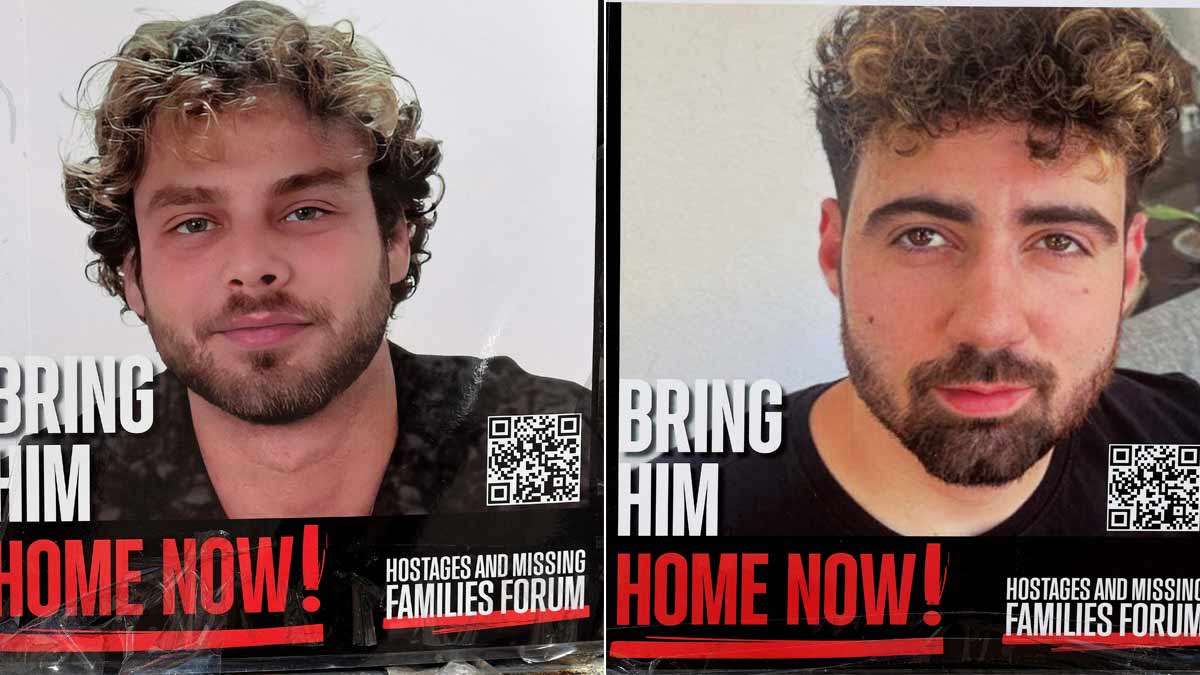Latest hostage video by Hamas deepens Israel’s agony as war crosses 700 days
 Posters with the portrait of Israeli hostages Alon Ohel and Guy Gilboa-Dalal held in the Gaza Strip since the October 7, 2023 attack by Hamas militants, hanging on a square outside the Tel Aviv Museum of Art | AFP
Posters with the portrait of Israeli hostages Alon Ohel and Guy Gilboa-Dalal held in the Gaza Strip since the October 7, 2023 attack by Hamas militants, hanging on a square outside the Tel Aviv Museum of Art | AFP
The release of a Hamas propaganda video featuring two Israeli hostages, Alon Ohel and Guy Gilboa-Dalal, on September 5 has reignited deep anguish in Israel and sharpened the debate over the country’s military campaign in Gaza City. It marked the first time in 700 days that the public has seen Ohel since his abduction during the Hamas-led assault of October 7, 2023, when about 250 people were seized.
The footage was a grim revelation of Ohel’s condition. His family, after consulting doctors in Israel and abroad, confirmed that he has lost sight in his right eye. His mother, Idit Ohel, said she could “hardly recognise” her son, describing his broken voice and his struggle to focus. Seeing him, she said, was at once “so moving after such a long time” and “hard to see him looking like that”.
Reports from hostages released in February had already painted a bleak picture. They said the 24-year-old pianist was chained underground in a Hamas tunnel, starved and denied treatment for multiple wounds. There were warnings even then that shrapnel injuries could cause blindness. His family stressed that international law forbids the holding of injured civilians without proper medical care, placing responsibility firmly on Hamas leaders.
The video, geolocated by CNN to Gaza City, also showed Gilboa-Dalal, partly filmed above ground in a car. He stated he had been held for 22 months, evidence that the video was recent. In one striking scene, he embraced Ohel, expressing disbelief at seeing him. Gilboa-Dalal urged Israel to end the offensive, warning that he and eight other hostages in Gaza City would “die here” if the assault continued. He appealed to Israelis to protest for an agreement that could save the 48 remaining hostages, of whom 20 are believed alive.
The timing of the release coincided with the 700th day of the war and the build-up to a major Israeli push into Gaza City. Hamas appeared intent on swaying Israeli public opinion, using the image of frail captives to amplify the costs of war.
Prime Minister Benjamin Netanyahu’s office responded that “no malicious propaganda video will weaken our resolve or divert us” from war aims. These goals, it reiterated, were the release of all hostages, the disarmament of Hamas, Israel’s security control of Gaza and the creation of an alternative civilian administration. Netanyahu also called the families of the two hostages after the video’s publication.
Not all were reassured. The Hostages and Missing Families Forum warned that the expanding assault endangered the captives, as the military lacked precise knowledge of their whereabouts. It urged a return to negotiations, insisting that “there is a deal on the table – this is what will bring back the last hostage, this is what will end the war”.
That demand echoed in mass protests across Israel. Tens of thousands filled the streets of Jerusalem and Tel Aviv, pressing for a deal. In Jerusalem, Einav Zangauker, mother of hostage Matan Zangauker, accused Netanyahu of prolonging the conflict to erase the shame of October 7, calling him “the worst enemy of the Jewish people”.
Meanwhile, the military situation in Gaza City grew more dire. The Israel Defense Forces claimed to hold 40 per cent of the city and over 70 per cent of the Strip, with operations set to expand. Satellite images reviewed by BBC Verify showed large sections of neighbourhoods such as Sheikh Radwan, Zeitoun and Tuffah reduced to rubble in the past month.
The humanitarian toll is severe. The United Nations and aid groups have warned of “horrific consequences”, citing mounting casualties including children, and confirmed famine inside Gaza City. Despite repeated calls to evacuate, only about 70,000 of the one million residents have left. Many of those who remain say they will not flee again, some declaring they prefer “death in my own home” to further displacement.
On the diplomatic front, negotiations remain stuck. Hamas has reportedly agreed to a plan brokered by Qatar and Egypt for a phased release of 10 living and 18 dead hostages in exchange for Palestinian prisoners. Israel has resisted, pressing instead for a comprehensive agreement covering all captives at once.
The appearance of Alon Ohel, gaunt and half-blind, alongside Gilboa-Dalal was a stark reminder of the human cost of the 700-day war. It underscored the pressure on Israel’s leaders, Hamas and international mediators alike to reach an agreement.
Middle East